Evidence for Nursing: Understanding Research Concepts
VerifiedAdded on 2023/01/18
|6
|2703
|77
AI Summary
This document provides an understanding of research concepts in nursing, including the role of evidence-based practice, integration of evidence-based practice in clinical judgment, barriers to implementation, strategies to facilitate evidence-based practice, and a review of a randomized controlled trial on total knee replacement.
Contribute Materials
Your contribution can guide someone’s learning journey. Share your
documents today.
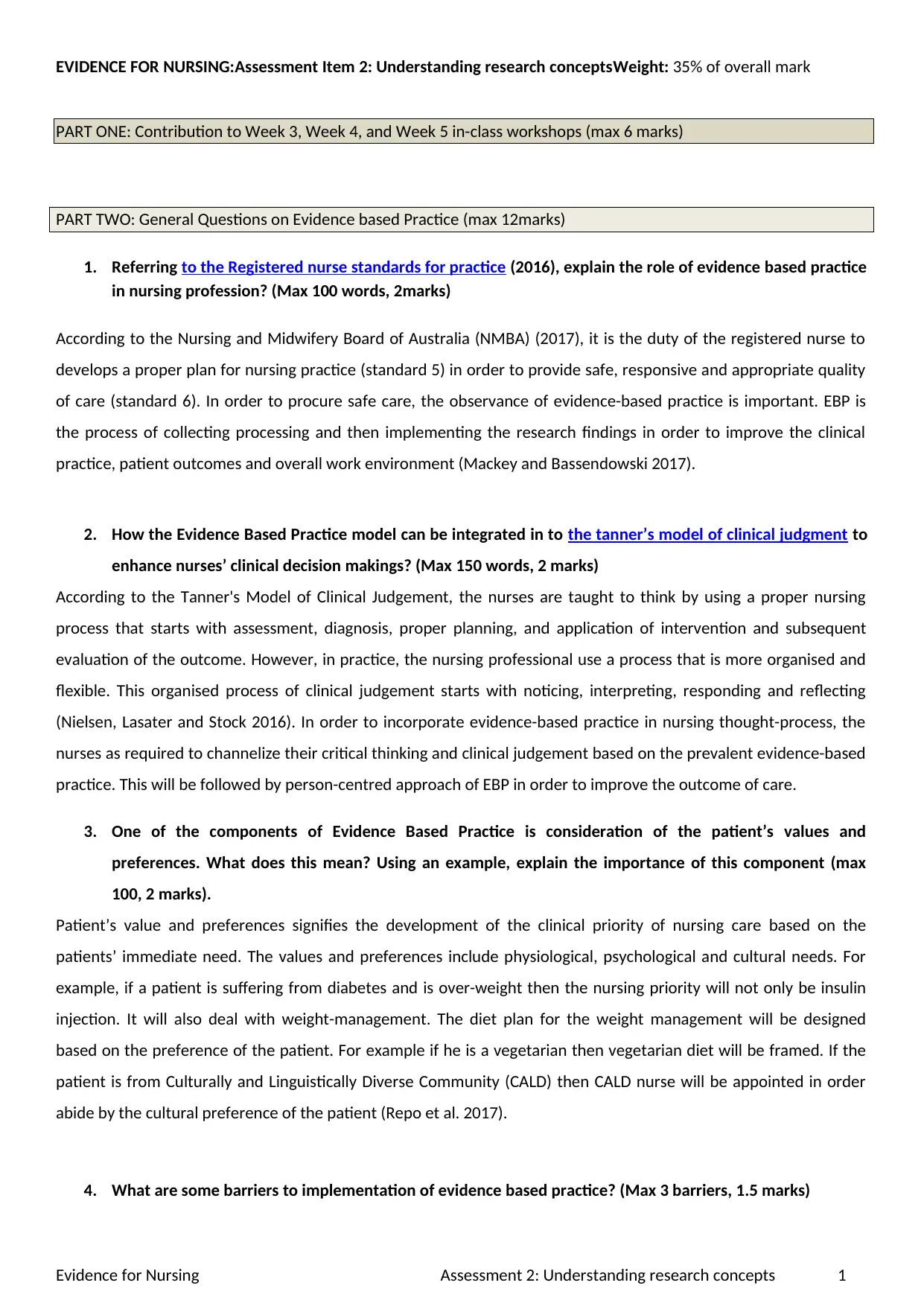
EVIDENCE FOR NURSING:Assessment Item 2: Understanding research conceptsWeight: 35% of overall mark
PART ONE: Contribution to Week 3, Week 4, and Week 5 in-class workshops (max 6 marks)
PART TWO: General Questions on Evidence based Practice (max 12marks)
1. Referring to the Registered nurse standards for practice (2016), explain the role of evidence based practice
in nursing profession? (Max 100 words, 2marks)
According to the Nursing and Midwifery Board of Australia (NMBA) (2017), it is the duty of the registered nurse to
develops a proper plan for nursing practice (standard 5) in order to provide safe, responsive and appropriate quality
of care (standard 6). In order to procure safe care, the observance of evidence-based practice is important. EBP is
the process of collecting processing and then implementing the research findings in order to improve the clinical
practice, patient outcomes and overall work environment (Mackey and Bassendowski 2017).
2. How the Evidence Based Practice model can be integrated in to the tanner’s model of clinical judgment to
enhance nurses’ clinical decision makings? (Max 150 words, 2 marks)
According to the Tanner's Model of Clinical Judgement, the nurses are taught to think by using a proper nursing
process that starts with assessment, diagnosis, proper planning, and application of intervention and subsequent
evaluation of the outcome. However, in practice, the nursing professional use a process that is more organised and
flexible. This organised process of clinical judgement starts with noticing, interpreting, responding and reflecting
(Nielsen, Lasater and Stock 2016). In order to incorporate evidence-based practice in nursing thought-process, the
nurses as required to channelize their critical thinking and clinical judgement based on the prevalent evidence-based
practice. This will be followed by person-centred approach of EBP in order to improve the outcome of care.
3. One of the components of Evidence Based Practice is consideration of the patient’s values and
preferences. What does this mean? Using an example, explain the importance of this component (max
100, 2 marks).
Patient’s value and preferences signifies the development of the clinical priority of nursing care based on the
patients’ immediate need. The values and preferences include physiological, psychological and cultural needs. For
example, if a patient is suffering from diabetes and is over-weight then the nursing priority will not only be insulin
injection. It will also deal with weight-management. The diet plan for the weight management will be designed
based on the preference of the patient. For example if he is a vegetarian then vegetarian diet will be framed. If the
patient is from Culturally and Linguistically Diverse Community (CALD) then CALD nurse will be appointed in order
abide by the cultural preference of the patient (Repo et al. 2017).
4. What are some barriers to implementation of evidence based practice? (Max 3 barriers, 1.5 marks)
Evidence for Nursing Assessment 2: Understanding research concepts 1
PART ONE: Contribution to Week 3, Week 4, and Week 5 in-class workshops (max 6 marks)
PART TWO: General Questions on Evidence based Practice (max 12marks)
1. Referring to the Registered nurse standards for practice (2016), explain the role of evidence based practice
in nursing profession? (Max 100 words, 2marks)
According to the Nursing and Midwifery Board of Australia (NMBA) (2017), it is the duty of the registered nurse to
develops a proper plan for nursing practice (standard 5) in order to provide safe, responsive and appropriate quality
of care (standard 6). In order to procure safe care, the observance of evidence-based practice is important. EBP is
the process of collecting processing and then implementing the research findings in order to improve the clinical
practice, patient outcomes and overall work environment (Mackey and Bassendowski 2017).
2. How the Evidence Based Practice model can be integrated in to the tanner’s model of clinical judgment to
enhance nurses’ clinical decision makings? (Max 150 words, 2 marks)
According to the Tanner's Model of Clinical Judgement, the nurses are taught to think by using a proper nursing
process that starts with assessment, diagnosis, proper planning, and application of intervention and subsequent
evaluation of the outcome. However, in practice, the nursing professional use a process that is more organised and
flexible. This organised process of clinical judgement starts with noticing, interpreting, responding and reflecting
(Nielsen, Lasater and Stock 2016). In order to incorporate evidence-based practice in nursing thought-process, the
nurses as required to channelize their critical thinking and clinical judgement based on the prevalent evidence-based
practice. This will be followed by person-centred approach of EBP in order to improve the outcome of care.
3. One of the components of Evidence Based Practice is consideration of the patient’s values and
preferences. What does this mean? Using an example, explain the importance of this component (max
100, 2 marks).
Patient’s value and preferences signifies the development of the clinical priority of nursing care based on the
patients’ immediate need. The values and preferences include physiological, psychological and cultural needs. For
example, if a patient is suffering from diabetes and is over-weight then the nursing priority will not only be insulin
injection. It will also deal with weight-management. The diet plan for the weight management will be designed
based on the preference of the patient. For example if he is a vegetarian then vegetarian diet will be framed. If the
patient is from Culturally and Linguistically Diverse Community (CALD) then CALD nurse will be appointed in order
abide by the cultural preference of the patient (Repo et al. 2017).
4. What are some barriers to implementation of evidence based practice? (Max 3 barriers, 1.5 marks)
Evidence for Nursing Assessment 2: Understanding research concepts 1
Secure Best Marks with AI Grader
Need help grading? Try our AI Grader for instant feedback on your assignments.
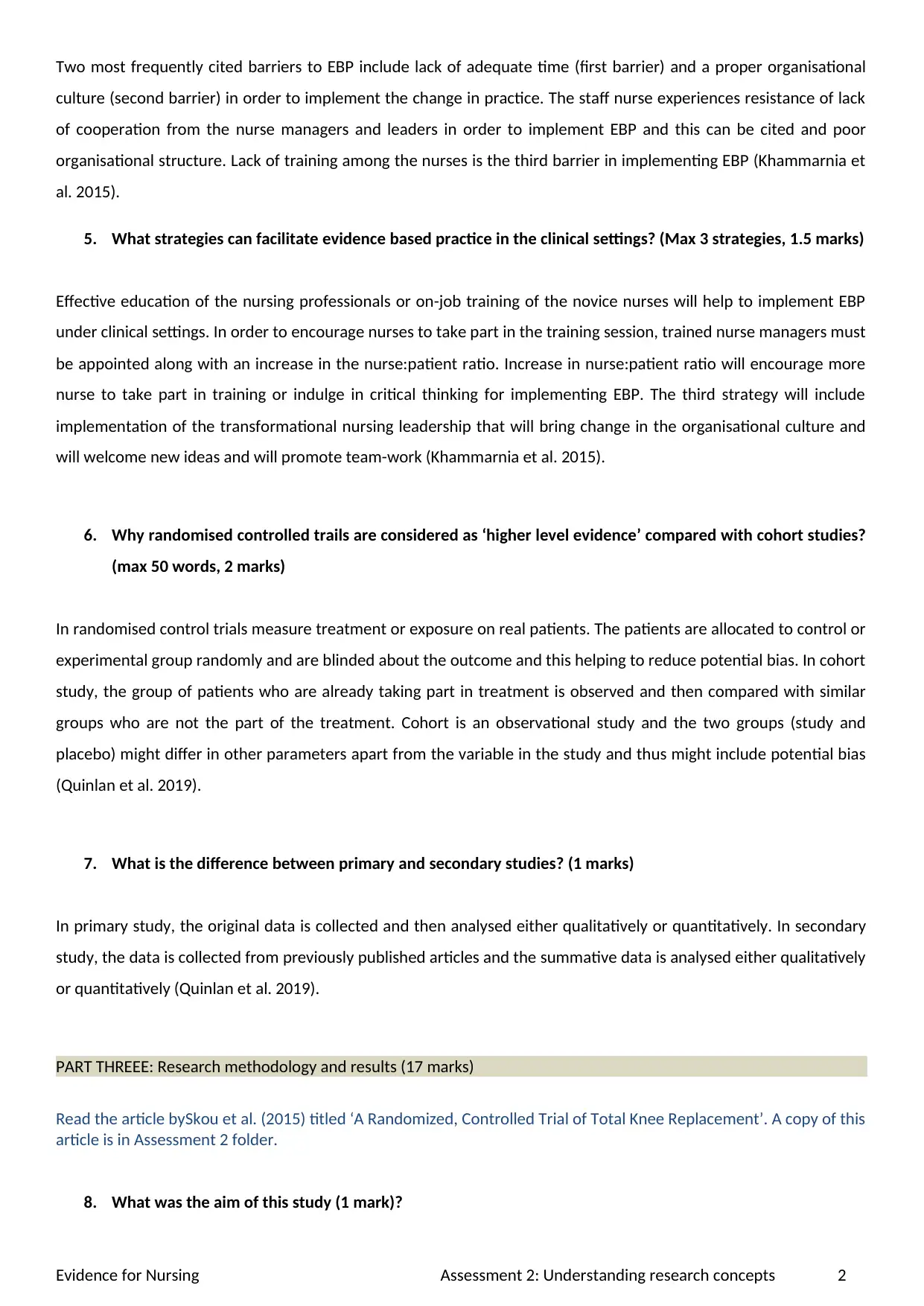
Two most frequently cited barriers to EBP include lack of adequate time (first barrier) and a proper organisational
culture (second barrier) in order to implement the change in practice. The staff nurse experiences resistance of lack
of cooperation from the nurse managers and leaders in order to implement EBP and this can be cited and poor
organisational structure. Lack of training among the nurses is the third barrier in implementing EBP (Khammarnia et
al. 2015).
5. What strategies can facilitate evidence based practice in the clinical settings? (Max 3 strategies, 1.5 marks)
Effective education of the nursing professionals or on-job training of the novice nurses will help to implement EBP
under clinical settings. In order to encourage nurses to take part in the training session, trained nurse managers must
be appointed along with an increase in the nurse:patient ratio. Increase in nurse:patient ratio will encourage more
nurse to take part in training or indulge in critical thinking for implementing EBP. The third strategy will include
implementation of the transformational nursing leadership that will bring change in the organisational culture and
will welcome new ideas and will promote team-work (Khammarnia et al. 2015).
6. Why randomised controlled trails are considered as ‘higher level evidence’ compared with cohort studies?
(max 50 words, 2 marks)
In randomised control trials measure treatment or exposure on real patients. The patients are allocated to control or
experimental group randomly and are blinded about the outcome and this helping to reduce potential bias. In cohort
study, the group of patients who are already taking part in treatment is observed and then compared with similar
groups who are not the part of the treatment. Cohort is an observational study and the two groups (study and
placebo) might differ in other parameters apart from the variable in the study and thus might include potential bias
(Quinlan et al. 2019).
7. What is the difference between primary and secondary studies? (1 marks)
In primary study, the original data is collected and then analysed either qualitatively or quantitatively. In secondary
study, the data is collected from previously published articles and the summative data is analysed either qualitatively
or quantitatively (Quinlan et al. 2019).
PART THREEE: Research methodology and results (17 marks)
Read the article bySkou et al. (2015) titled ‘A Randomized, Controlled Trial of Total Knee Replacement’. A copy of this
article is in Assessment 2 folder.
8. What was the aim of this study (1 mark)?
Evidence for Nursing Assessment 2: Understanding research concepts 2
culture (second barrier) in order to implement the change in practice. The staff nurse experiences resistance of lack
of cooperation from the nurse managers and leaders in order to implement EBP and this can be cited and poor
organisational structure. Lack of training among the nurses is the third barrier in implementing EBP (Khammarnia et
al. 2015).
5. What strategies can facilitate evidence based practice in the clinical settings? (Max 3 strategies, 1.5 marks)
Effective education of the nursing professionals or on-job training of the novice nurses will help to implement EBP
under clinical settings. In order to encourage nurses to take part in the training session, trained nurse managers must
be appointed along with an increase in the nurse:patient ratio. Increase in nurse:patient ratio will encourage more
nurse to take part in training or indulge in critical thinking for implementing EBP. The third strategy will include
implementation of the transformational nursing leadership that will bring change in the organisational culture and
will welcome new ideas and will promote team-work (Khammarnia et al. 2015).
6. Why randomised controlled trails are considered as ‘higher level evidence’ compared with cohort studies?
(max 50 words, 2 marks)
In randomised control trials measure treatment or exposure on real patients. The patients are allocated to control or
experimental group randomly and are blinded about the outcome and this helping to reduce potential bias. In cohort
study, the group of patients who are already taking part in treatment is observed and then compared with similar
groups who are not the part of the treatment. Cohort is an observational study and the two groups (study and
placebo) might differ in other parameters apart from the variable in the study and thus might include potential bias
(Quinlan et al. 2019).
7. What is the difference between primary and secondary studies? (1 marks)
In primary study, the original data is collected and then analysed either qualitatively or quantitatively. In secondary
study, the data is collected from previously published articles and the summative data is analysed either qualitatively
or quantitatively (Quinlan et al. 2019).
PART THREEE: Research methodology and results (17 marks)
Read the article bySkou et al. (2015) titled ‘A Randomized, Controlled Trial of Total Knee Replacement’. A copy of this
article is in Assessment 2 folder.
8. What was the aim of this study (1 mark)?
Evidence for Nursing Assessment 2: Understanding research concepts 2
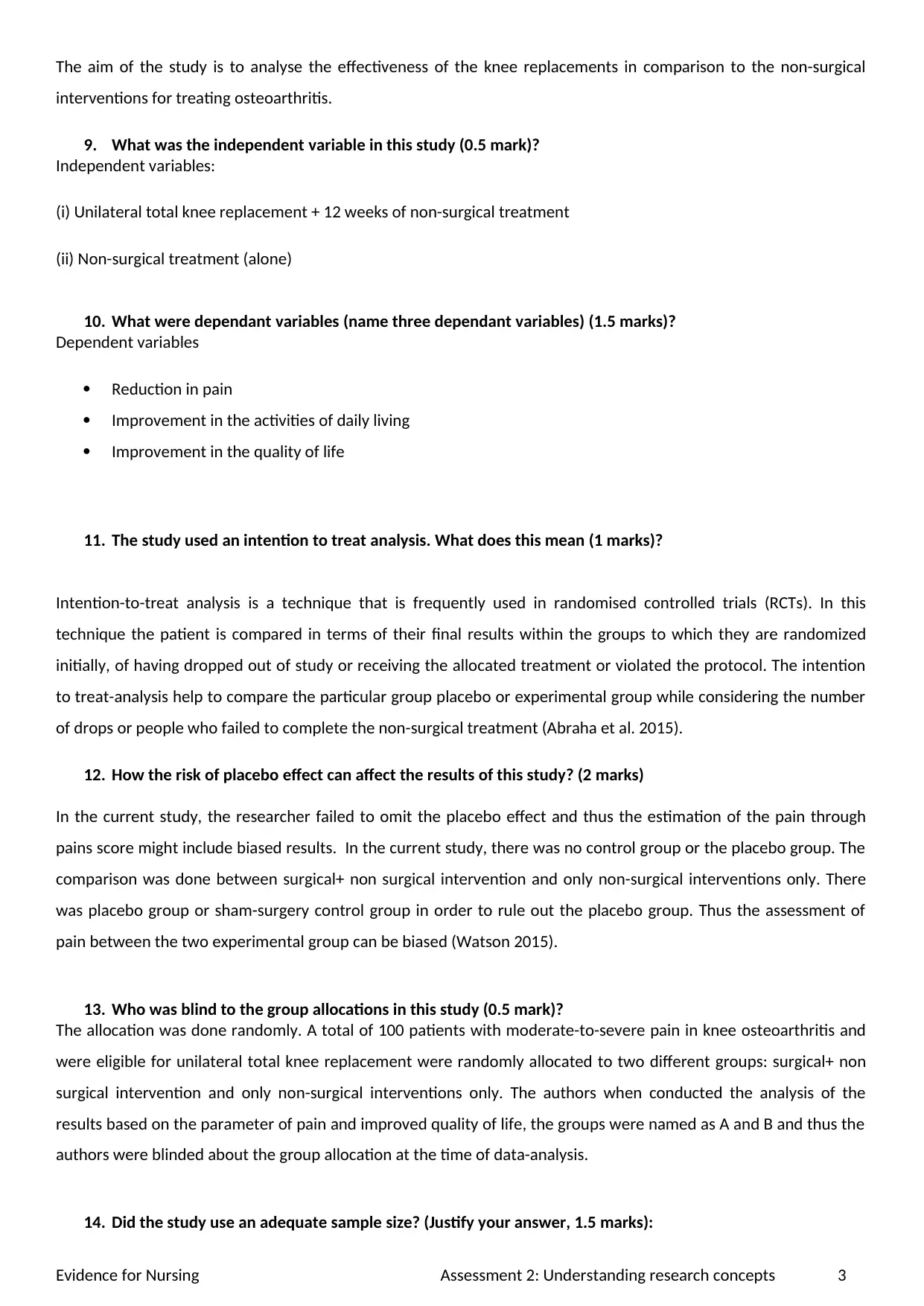
The aim of the study is to analyse the effectiveness of the knee replacements in comparison to the non-surgical
interventions for treating osteoarthritis.
9. What was the independent variable in this study (0.5 mark)?
Independent variables:
(i) Unilateral total knee replacement + 12 weeks of non-surgical treatment
(ii) Non-surgical treatment (alone)
10. What were dependant variables (name three dependant variables) (1.5 marks)?
Dependent variables
Reduction in pain
Improvement in the activities of daily living
Improvement in the quality of life
11. The study used an intention to treat analysis. What does this mean (1 marks)?
Intention-to-treat analysis is a technique that is frequently used in randomised controlled trials (RCTs). In this
technique the patient is compared in terms of their final results within the groups to which they are randomized
initially, of having dropped out of study or receiving the allocated treatment or violated the protocol. The intention
to treat-analysis help to compare the particular group placebo or experimental group while considering the number
of drops or people who failed to complete the non-surgical treatment (Abraha et al. 2015).
12. How the risk of placebo effect can affect the results of this study? (2 marks)
In the current study, the researcher failed to omit the placebo effect and thus the estimation of the pain through
pains score might include biased results. In the current study, there was no control group or the placebo group. The
comparison was done between surgical+ non surgical intervention and only non-surgical interventions only. There
was placebo group or sham-surgery control group in order to rule out the placebo group. Thus the assessment of
pain between the two experimental group can be biased (Watson 2015).
13. Who was blind to the group allocations in this study (0.5 mark)?
The allocation was done randomly. A total of 100 patients with moderate-to-severe pain in knee osteoarthritis and
were eligible for unilateral total knee replacement were randomly allocated to two different groups: surgical+ non
surgical intervention and only non-surgical interventions only. The authors when conducted the analysis of the
results based on the parameter of pain and improved quality of life, the groups were named as A and B and thus the
authors were blinded about the group allocation at the time of data-analysis.
14. Did the study use an adequate sample size? (Justify your answer, 1.5 marks):
Evidence for Nursing Assessment 2: Understanding research concepts 3
interventions for treating osteoarthritis.
9. What was the independent variable in this study (0.5 mark)?
Independent variables:
(i) Unilateral total knee replacement + 12 weeks of non-surgical treatment
(ii) Non-surgical treatment (alone)
10. What were dependant variables (name three dependant variables) (1.5 marks)?
Dependent variables
Reduction in pain
Improvement in the activities of daily living
Improvement in the quality of life
11. The study used an intention to treat analysis. What does this mean (1 marks)?
Intention-to-treat analysis is a technique that is frequently used in randomised controlled trials (RCTs). In this
technique the patient is compared in terms of their final results within the groups to which they are randomized
initially, of having dropped out of study or receiving the allocated treatment or violated the protocol. The intention
to treat-analysis help to compare the particular group placebo or experimental group while considering the number
of drops or people who failed to complete the non-surgical treatment (Abraha et al. 2015).
12. How the risk of placebo effect can affect the results of this study? (2 marks)
In the current study, the researcher failed to omit the placebo effect and thus the estimation of the pain through
pains score might include biased results. In the current study, there was no control group or the placebo group. The
comparison was done between surgical+ non surgical intervention and only non-surgical interventions only. There
was placebo group or sham-surgery control group in order to rule out the placebo group. Thus the assessment of
pain between the two experimental group can be biased (Watson 2015).
13. Who was blind to the group allocations in this study (0.5 mark)?
The allocation was done randomly. A total of 100 patients with moderate-to-severe pain in knee osteoarthritis and
were eligible for unilateral total knee replacement were randomly allocated to two different groups: surgical+ non
surgical intervention and only non-surgical interventions only. The authors when conducted the analysis of the
results based on the parameter of pain and improved quality of life, the groups were named as A and B and thus the
authors were blinded about the group allocation at the time of data-analysis.
14. Did the study use an adequate sample size? (Justify your answer, 1.5 marks):
Evidence for Nursing Assessment 2: Understanding research concepts 3
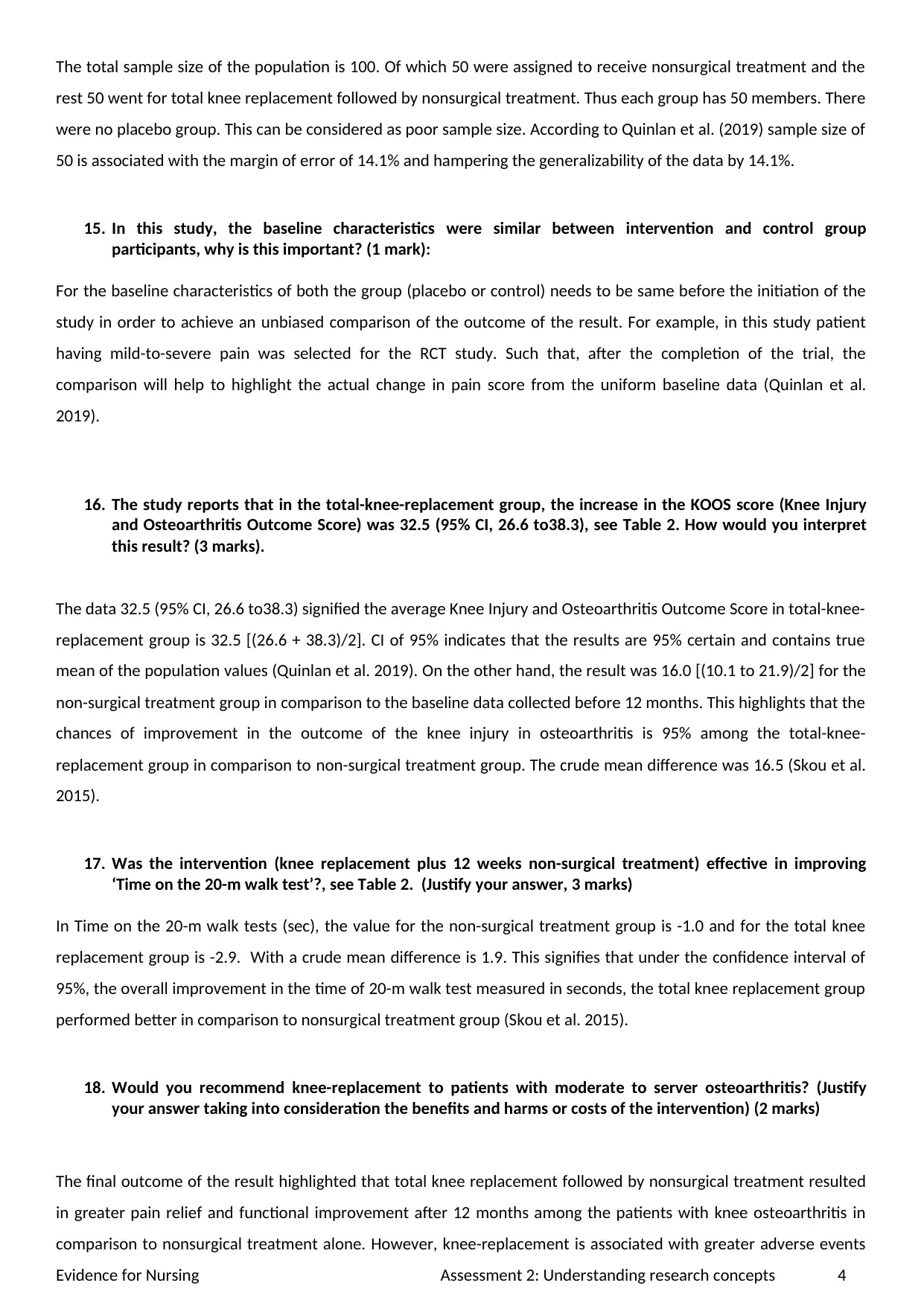
The total sample size of the population is 100. Of which 50 were assigned to receive nonsurgical treatment and the
rest 50 went for total knee replacement followed by nonsurgical treatment. Thus each group has 50 members. There
were no placebo group. This can be considered as poor sample size. According to Quinlan et al. (2019) sample size of
50 is associated with the margin of error of 14.1% and hampering the generalizability of the data by 14.1%.
15. In this study, the baseline characteristics were similar between intervention and control group
participants, why is this important? (1 mark):
For the baseline characteristics of both the group (placebo or control) needs to be same before the initiation of the
study in order to achieve an unbiased comparison of the outcome of the result. For example, in this study patient
having mild-to-severe pain was selected for the RCT study. Such that, after the completion of the trial, the
comparison will help to highlight the actual change in pain score from the uniform baseline data (Quinlan et al.
2019).
16. The study reports that in the total-knee-replacement group, the increase in the KOOS score (Knee Injury
and Osteoarthritis Outcome Score) was 32.5 (95% CI, 26.6 to38.3), see Table 2. How would you interpret
this result? (3 marks).
The data 32.5 (95% CI, 26.6 to38.3) signified the average Knee Injury and Osteoarthritis Outcome Score in total-knee-
replacement group is 32.5 [(26.6 + 38.3)/2]. CI of 95% indicates that the results are 95% certain and contains true
mean of the population values (Quinlan et al. 2019). On the other hand, the result was 16.0 [(10.1 to 21.9)/2] for the
non-surgical treatment group in comparison to the baseline data collected before 12 months. This highlights that the
chances of improvement in the outcome of the knee injury in osteoarthritis is 95% among the total-knee-
replacement group in comparison to non-surgical treatment group. The crude mean difference was 16.5 (Skou et al.
2015).
17. Was the intervention (knee replacement plus 12 weeks non-surgical treatment) effective in improving
‘Time on the 20-m walk test’?, see Table 2. (Justify your answer, 3 marks)
In Time on the 20-m walk tests (sec), the value for the non-surgical treatment group is -1.0 and for the total knee
replacement group is -2.9. With a crude mean difference is 1.9. This signifies that under the confidence interval of
95%, the overall improvement in the time of 20-m walk test measured in seconds, the total knee replacement group
performed better in comparison to nonsurgical treatment group (Skou et al. 2015).
18. Would you recommend knee-replacement to patients with moderate to server osteoarthritis? (Justify
your answer taking into consideration the benefits and harms or costs of the intervention) (2 marks)
The final outcome of the result highlighted that total knee replacement followed by nonsurgical treatment resulted
in greater pain relief and functional improvement after 12 months among the patients with knee osteoarthritis in
comparison to nonsurgical treatment alone. However, knee-replacement is associated with greater adverse events
Evidence for Nursing Assessment 2: Understanding research concepts 4
rest 50 went for total knee replacement followed by nonsurgical treatment. Thus each group has 50 members. There
were no placebo group. This can be considered as poor sample size. According to Quinlan et al. (2019) sample size of
50 is associated with the margin of error of 14.1% and hampering the generalizability of the data by 14.1%.
15. In this study, the baseline characteristics were similar between intervention and control group
participants, why is this important? (1 mark):
For the baseline characteristics of both the group (placebo or control) needs to be same before the initiation of the
study in order to achieve an unbiased comparison of the outcome of the result. For example, in this study patient
having mild-to-severe pain was selected for the RCT study. Such that, after the completion of the trial, the
comparison will help to highlight the actual change in pain score from the uniform baseline data (Quinlan et al.
2019).
16. The study reports that in the total-knee-replacement group, the increase in the KOOS score (Knee Injury
and Osteoarthritis Outcome Score) was 32.5 (95% CI, 26.6 to38.3), see Table 2. How would you interpret
this result? (3 marks).
The data 32.5 (95% CI, 26.6 to38.3) signified the average Knee Injury and Osteoarthritis Outcome Score in total-knee-
replacement group is 32.5 [(26.6 + 38.3)/2]. CI of 95% indicates that the results are 95% certain and contains true
mean of the population values (Quinlan et al. 2019). On the other hand, the result was 16.0 [(10.1 to 21.9)/2] for the
non-surgical treatment group in comparison to the baseline data collected before 12 months. This highlights that the
chances of improvement in the outcome of the knee injury in osteoarthritis is 95% among the total-knee-
replacement group in comparison to non-surgical treatment group. The crude mean difference was 16.5 (Skou et al.
2015).
17. Was the intervention (knee replacement plus 12 weeks non-surgical treatment) effective in improving
‘Time on the 20-m walk test’?, see Table 2. (Justify your answer, 3 marks)
In Time on the 20-m walk tests (sec), the value for the non-surgical treatment group is -1.0 and for the total knee
replacement group is -2.9. With a crude mean difference is 1.9. This signifies that under the confidence interval of
95%, the overall improvement in the time of 20-m walk test measured in seconds, the total knee replacement group
performed better in comparison to nonsurgical treatment group (Skou et al. 2015).
18. Would you recommend knee-replacement to patients with moderate to server osteoarthritis? (Justify
your answer taking into consideration the benefits and harms or costs of the intervention) (2 marks)
The final outcome of the result highlighted that total knee replacement followed by nonsurgical treatment resulted
in greater pain relief and functional improvement after 12 months among the patients with knee osteoarthritis in
comparison to nonsurgical treatment alone. However, knee-replacement is associated with greater adverse events
Evidence for Nursing Assessment 2: Understanding research concepts 4
Secure Best Marks with AI Grader
Need help grading? Try our AI Grader for instant feedback on your assignments.
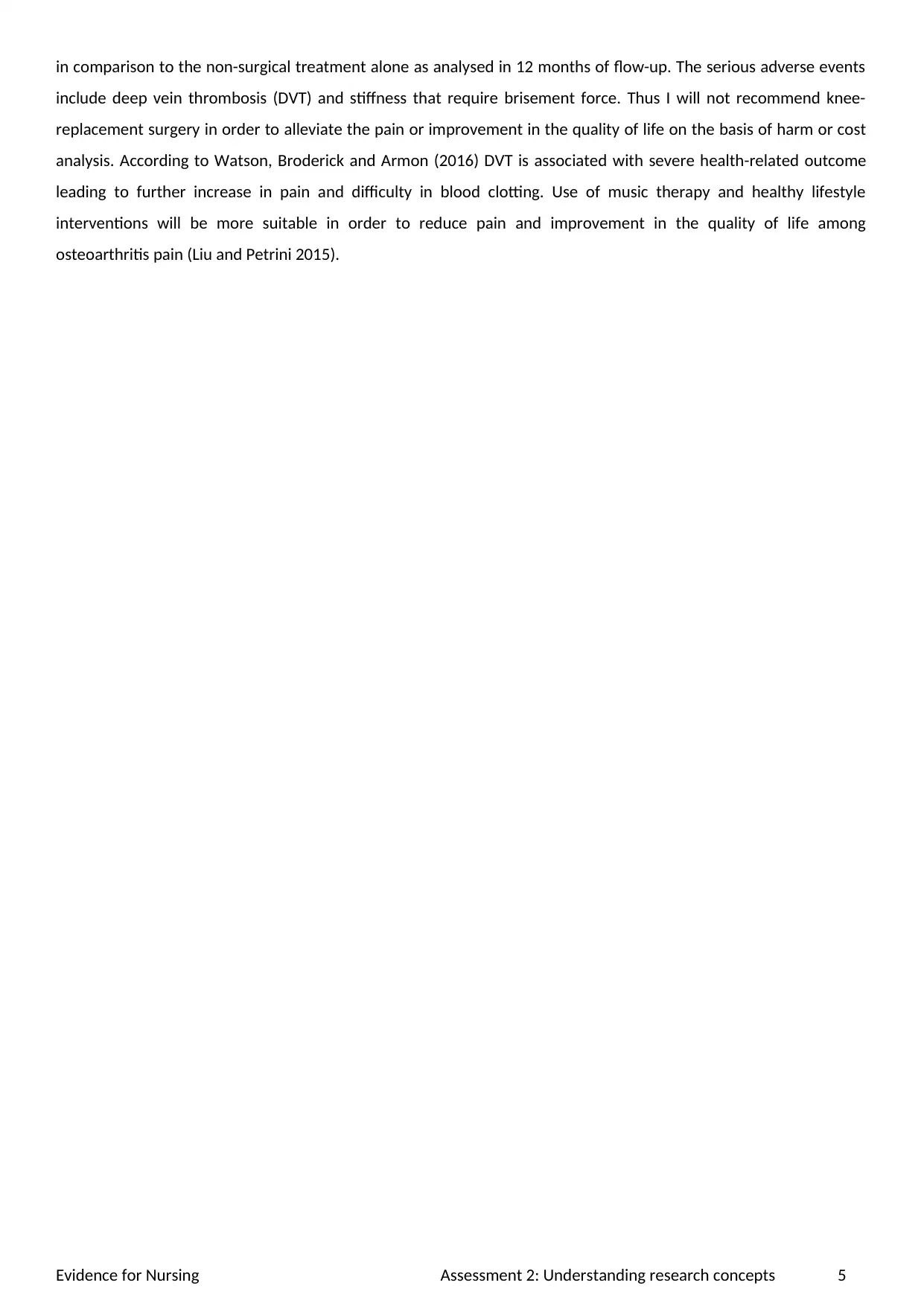
in comparison to the non-surgical treatment alone as analysed in 12 months of flow-up. The serious adverse events
include deep vein thrombosis (DVT) and stiffness that require brisement force. Thus I will not recommend knee-
replacement surgery in order to alleviate the pain or improvement in the quality of life on the basis of harm or cost
analysis. According to Watson, Broderick and Armon (2016) DVT is associated with severe health-related outcome
leading to further increase in pain and difficulty in blood clotting. Use of music therapy and healthy lifestyle
interventions will be more suitable in order to reduce pain and improvement in the quality of life among
osteoarthritis pain (Liu and Petrini 2015).
Evidence for Nursing Assessment 2: Understanding research concepts 5
include deep vein thrombosis (DVT) and stiffness that require brisement force. Thus I will not recommend knee-
replacement surgery in order to alleviate the pain or improvement in the quality of life on the basis of harm or cost
analysis. According to Watson, Broderick and Armon (2016) DVT is associated with severe health-related outcome
leading to further increase in pain and difficulty in blood clotting. Use of music therapy and healthy lifestyle
interventions will be more suitable in order to reduce pain and improvement in the quality of life among
osteoarthritis pain (Liu and Petrini 2015).
Evidence for Nursing Assessment 2: Understanding research concepts 5
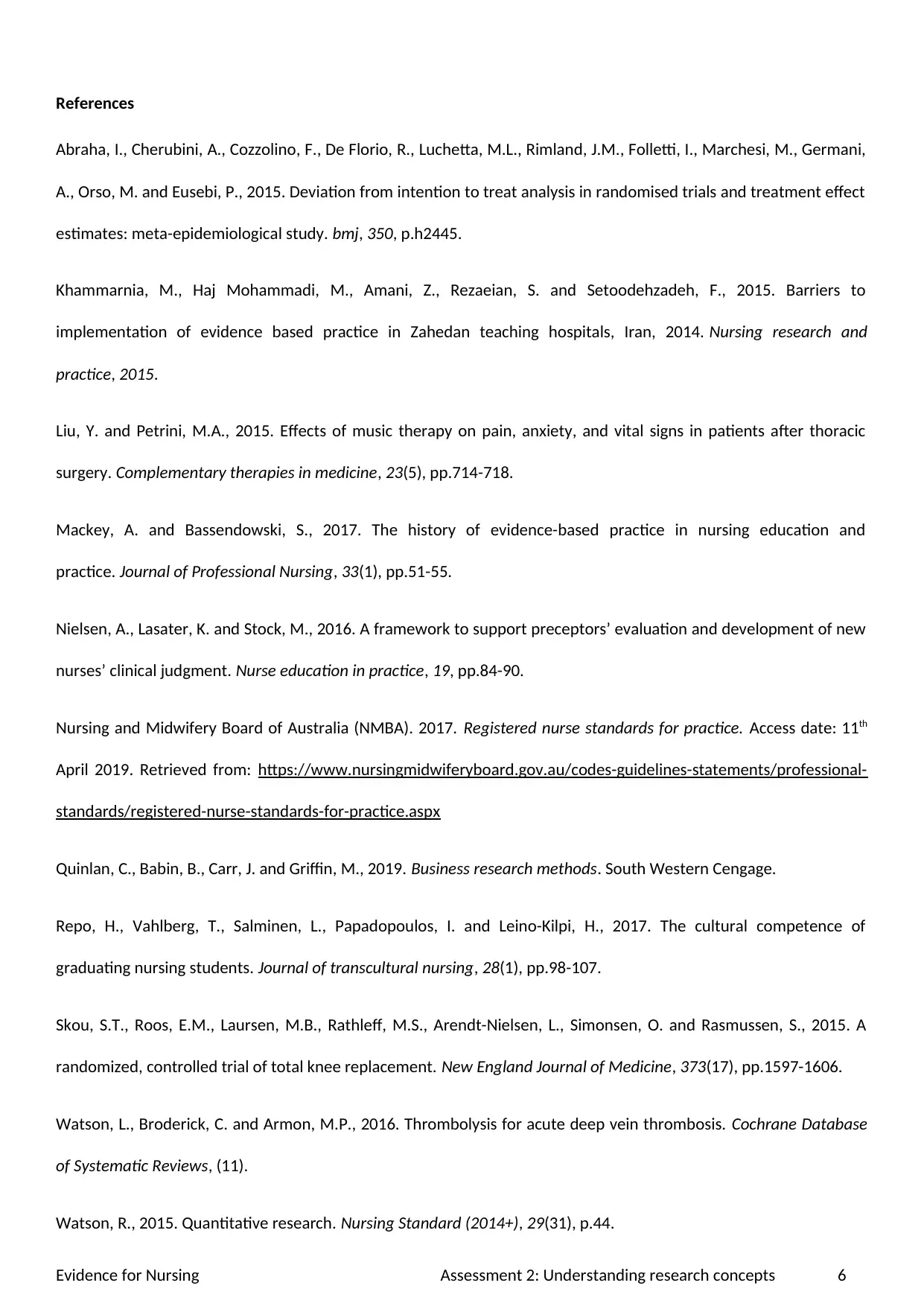
References
Abraha, I., Cherubini, A., Cozzolino, F., De Florio, R., Luchetta, M.L., Rimland, J.M., Folletti, I., Marchesi, M., Germani,
A., Orso, M. and Eusebi, P., 2015. Deviation from intention to treat analysis in randomised trials and treatment effect
estimates: meta-epidemiological study. bmj, 350, p.h2445.
Khammarnia, M., Haj Mohammadi, M., Amani, Z., Rezaeian, S. and Setoodehzadeh, F., 2015. Barriers to
implementation of evidence based practice in Zahedan teaching hospitals, Iran, 2014. Nursing research and
practice, 2015.
Liu, Y. and Petrini, M.A., 2015. Effects of music therapy on pain, anxiety, and vital signs in patients after thoracic
surgery. Complementary therapies in medicine, 23(5), pp.714-718.
Mackey, A. and Bassendowski, S., 2017. The history of evidence-based practice in nursing education and
practice. Journal of Professional Nursing, 33(1), pp.51-55.
Nielsen, A., Lasater, K. and Stock, M., 2016. A framework to support preceptors’ evaluation and development of new
nurses’ clinical judgment. Nurse education in practice, 19, pp.84-90.
Nursing and Midwifery Board of Australia (NMBA). 2017. Registered nurse standards for practice. Access date: 11th
April 2019. Retrieved from: https://www.nursingmidwiferyboard.gov.au/codes-guidelines-statements/professional-
standards/registered-nurse-standards-for-practice.aspx
Quinlan, C., Babin, B., Carr, J. and Griffin, M., 2019. Business research methods. South Western Cengage.
Repo, H., Vahlberg, T., Salminen, L., Papadopoulos, I. and Leino-Kilpi, H., 2017. The cultural competence of
graduating nursing students. Journal of transcultural nursing, 28(1), pp.98-107.
Skou, S.T., Roos, E.M., Laursen, M.B., Rathleff, M.S., Arendt-Nielsen, L., Simonsen, O. and Rasmussen, S., 2015. A
randomized, controlled trial of total knee replacement. New England Journal of Medicine, 373(17), pp.1597-1606.
Watson, L., Broderick, C. and Armon, M.P., 2016. Thrombolysis for acute deep vein thrombosis. Cochrane Database
of Systematic Reviews, (11).
Watson, R., 2015. Quantitative research. Nursing Standard (2014+), 29(31), p.44.
Evidence for Nursing Assessment 2: Understanding research concepts 6
Abraha, I., Cherubini, A., Cozzolino, F., De Florio, R., Luchetta, M.L., Rimland, J.M., Folletti, I., Marchesi, M., Germani,
A., Orso, M. and Eusebi, P., 2015. Deviation from intention to treat analysis in randomised trials and treatment effect
estimates: meta-epidemiological study. bmj, 350, p.h2445.
Khammarnia, M., Haj Mohammadi, M., Amani, Z., Rezaeian, S. and Setoodehzadeh, F., 2015. Barriers to
implementation of evidence based practice in Zahedan teaching hospitals, Iran, 2014. Nursing research and
practice, 2015.
Liu, Y. and Petrini, M.A., 2015. Effects of music therapy on pain, anxiety, and vital signs in patients after thoracic
surgery. Complementary therapies in medicine, 23(5), pp.714-718.
Mackey, A. and Bassendowski, S., 2017. The history of evidence-based practice in nursing education and
practice. Journal of Professional Nursing, 33(1), pp.51-55.
Nielsen, A., Lasater, K. and Stock, M., 2016. A framework to support preceptors’ evaluation and development of new
nurses’ clinical judgment. Nurse education in practice, 19, pp.84-90.
Nursing and Midwifery Board of Australia (NMBA). 2017. Registered nurse standards for practice. Access date: 11th
April 2019. Retrieved from: https://www.nursingmidwiferyboard.gov.au/codes-guidelines-statements/professional-
standards/registered-nurse-standards-for-practice.aspx
Quinlan, C., Babin, B., Carr, J. and Griffin, M., 2019. Business research methods. South Western Cengage.
Repo, H., Vahlberg, T., Salminen, L., Papadopoulos, I. and Leino-Kilpi, H., 2017. The cultural competence of
graduating nursing students. Journal of transcultural nursing, 28(1), pp.98-107.
Skou, S.T., Roos, E.M., Laursen, M.B., Rathleff, M.S., Arendt-Nielsen, L., Simonsen, O. and Rasmussen, S., 2015. A
randomized, controlled trial of total knee replacement. New England Journal of Medicine, 373(17), pp.1597-1606.
Watson, L., Broderick, C. and Armon, M.P., 2016. Thrombolysis for acute deep vein thrombosis. Cochrane Database
of Systematic Reviews, (11).
Watson, R., 2015. Quantitative research. Nursing Standard (2014+), 29(31), p.44.
Evidence for Nursing Assessment 2: Understanding research concepts 6
1 out of 6
Related Documents
Your All-in-One AI-Powered Toolkit for Academic Success.
+13062052269
info@desklib.com
Available 24*7 on WhatsApp / Email
![[object Object]](/_next/static/media/star-bottom.7253800d.svg)
Unlock your academic potential
© 2024 | Zucol Services PVT LTD | All rights reserved.





